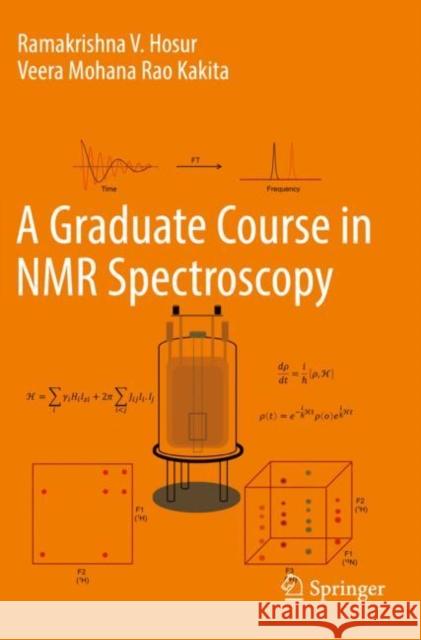A Graduate Course in NMR Spectroscopy » książka



A Graduate Course in NMR Spectroscopy
ISBN-13: 9783030887711 / Angielski / Miękka / 2023 / 313 str.
A Graduate Course in NMR Spectroscopy
ISBN-13: 9783030887711 / Angielski / Miękka / 2023 / 313 str.
(netto: 232,57 VAT: 5%)
Najniższa cena z 30 dni: 244,20 zł
ok. 16-18 dni roboczych.
Darmowa dostawa!
Chapter-1: BASIC CONCEPTS
1.1 Nuclear Spin and Magnetic Moments
1.2 Nuclear Spins in a Magnetic Field
1.3 Spin Lattice Relaxation
1.4 Spin temperature1.5 Resonance Absorption of Energy and The NMR Experiment
1.5.1. The basic NMR spectrometer
1.6 Kinetics of Resonance Absorption
1.7 Selection Rules
1.8 Line widths
1.9 Bloch equations
1.10 More about relaxation
1.11 SensitivityEXERCISES
CHAPTER 2: HIGH RESOLUTION NMR SPECTRA OF MOLECULES
2.1 Introduction
2.2 Chemical Shift
2.2.1 Anisotropy of chemical shifts
2.2.2 Factors Influencing Isotropic Chemical shifts
2.3 Spin-Spin Coupling
2.4 Analysis of NMR spectra of molecules
2.4.1 First Order Analysis
2.4.2 Quantum Mechanical Analysis2.5 Dynamic Effects in the NMR spectra
2.5.1 Two site Chemical Exchange
2.5.2. Collapse of spin multiplets
2.5.3 Conformational Averaging of J- values
EXERCISES
CHAPTER 3: FOURIER TRANSFORM NMR
3.1 Introduction
3.2 Principles of Fourier transform NMR
3.3 Theorems on Fourier transforms
3.4 The FTNMR Spectrometer3.5. Practical aspects of recording FTNMR spectra
3.5.1. Carrier Frequency and off-set
3.5.2. RF pulse3.5.3. Free Induction Decay (FID) and the spectrum
3.5.4. Single channel and quadrature detection
3.5.5. Signal digitization and sampling3.5.6. Folding of signals
3.5.7. Acquisition time and the resolution
3.5.8. Signal averaging and Pulse repetition rate3.6. Data processing in FT NMR
3.6.1. Zero filling
3.6.2. Digital filtration or window multiplication or apodization3.7 Phase correction
3.8. Dynamic range in FTNMR
3.9. Spin-echo3.10. Measurement of relaxation times
3.10.1. Measurement of relaxation time
3.10.2. Measurement of relaxation time3.11. Water suppression through spin-echo: Watergate
3.12 Spin decoupling
3.13 Broad band decoupling
3.14 Biliniear Rotational Decoupling (BIRD)EXERCISES
CHAPTER 4: POLARIZATION TRANSFER
4.1 Introduction
4.2 Experimental Schemes
4.3 Origin of NOE
4.3.1 A simplified treatment
4.3.2 A more rigorous treatment4.4 Steady state NOE
4.5 Transient NOE
4.6. Selective population inversion
4.7. INEPT
4.7.1. Disadvantages of INEPT
4.8 Refocused INEPT
4.9 DEPT
EXERCISES
CHAPTER 5: Density matrix description of NMR
5.1 Introduction
5.2 Density matrix5.3 Elements of Density Matrix
5.4. Time evolution of density operator
5.5. Matrix representations of RF pulses
5.6. Product Operator Formalism
5.6.1. Basis operator sets
5.6.2. Time-evolution of Cartesian Basis Operators
5.6.2.1 Free evolution under the influence of the Hamiltonian5.6.2.2 Chemical Shift evolution
5.6.2.3 Scalar coupling evolution
5.6.2.4 Rotation by pulses5.6.2.5 Calculation of the spectrum of J-coupled two spin system
EXERCISES
Chapter 6: Multidimensional NMR Spectroscopy
6.1 Segmentation of the time axis
6.2 Two dimensional NMR6.3 Two-dimensional Fourier Transformation in NMR
6.4 Peak shapes in 2D spectrum
6.5 Quadrature detection in two-dimensional NMR6.6 Types of 2D-NMR spectra
6.6.1 2D- resolution/ separation experiments
6.6.2. Two-dimensional correlation experiments
6.6.2.1 The COSY experiment
6.6.2.1.1 COSY of two-spins
6.6.2.1.2 COSY of three-spins
6.6.2.1.3 Disadvantages of COSY
6.6.2.2 Double-Quantum Filtered COSY (DQF-COSY)
6.6.2.3 Total Correlation Spectroscopy (TOCSY)
6.6.2.4 Two-dimensional Nuclear Overhauser Effect spectroscopy (2D-NOESY)
6.6.2.5 Two-dimensional ROESY
6.6.3 Two-dimensional heteronuclear correlation experiments
6.6.3.1 Heteronuclear COSY
6.6.3.2 Heteronuclear Multiple Bond Correlation (HMBC)
6.6.3.3 Combination of mixing sequences
6.7 Three dimensional NMR
6.7.1 The CT-HNCA experiment
6.7.2 The HNN experiment6.7.3 The constant-time HN(CO)CA experiment
6.7.4 The HN(C)N experimentEXERCISES
APPENDIX
A1. Hamiltonian of dipole-dipole interactionA2. Chemical Shift Anisotropy
A3. Solid state NMR: basic features
A4. Coherence selection by linear Field Gradients
A5. Pure shift NMR: ZS and PSYCHE methods
A6. HADAMARD NMR for selective excitation
Ramakrishna V Hosur (b. 1953) received a Ph. D. (Chemistry) from TIFR (University of Mumbai) in 1979. He was a post-doctoral fellow at ETH Zurich (1981-83) in the group of Prof. Kurt Wuthrich and also collaborated with Prof. Richard Ernst. He has been employed at TIFR since 1978, and retired as Senior Professor in May 2018. He was also Director of the University of Mumbai (UM) – Department of Atomic Energy (DAE) Centre for Excellence in Basic Sciences (CEBS), abbreviated as UM-DAE CEBS, from December 2009 till October 2017. He was the Convener of the National Facility for High Field NMR at TIFR during 2002-2018. Currently, he is associated with CEBS and also with IIT-Bombay. His research has been in the area of NMR and its applications in chemistry and biology over the last four decades. His work has been recognized by several awards, such as Young Scientist Medal of the Indian National Science Academy, BM Birla Award, GN Ramachandran Gold Medal of CSIR, Govt of India, JC Bose National Fellowship, to name a few. He has been awarded ‘Padmashri’ by the President of India in 2014. He is an elected Fellow of International Society of Magnetic Resonance (ISMAR), The World Academy of Sciences (TWAS), and all the Science Academies of India.
Veera Mohana Rao Kakita (b. 1983) is currently a Dr DS Kothari postdoctoral fellow at the School of Chemistry, University of Mumbai (UM) - Department of Atomic Energy (DAE), Centre for Excellence in Basic Sciences (UM-DAE CEBS), Mumbai, India. He obtained his PhD in Nuclear Magnetic Resonance from the University of Hyderabad/ CSIR-Indian Institute of Chemical Technology, Hyderabad in 2014. He is the recipient of the CBMR-NMRS gold medal (in 2016) for his research excellence in NMR spectroscopy. His areas of interest are developing high-resolution NMR methods and their applications, Hadamard NMR spectroscopy, pure shift NMR, NMR super sequences, metabolomics, and applications of Machine Learning/ Artificial Intelligence techniques in chemistry.
This textbook is designed for graduate students to introduce the basic concepts of Nuclear Magnetic Resonance spectroscopy (NMR), spectral analysis and modern developments such as multidimensional NMR, in reasonable detail and rigor. The book is self-contained, so, a unique textbook in that sense with end of chapter exercises included supported by a solution manual. Some of the advanced topics are included as Appendices for quick reference. Students of chemistry who have some exposure to mathematics and physics will benefit from this book and it will prepare them to pursue research in different branches of Chemistry or Biophysics or Structural Biology.
1997-2025 DolnySlask.com Agencja Internetowa
KrainaKsiazek.PL - Księgarnia Internetowa









